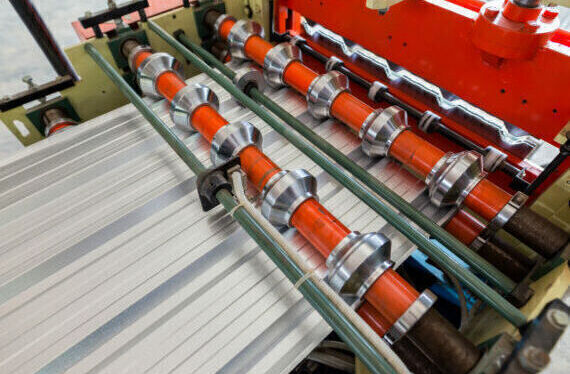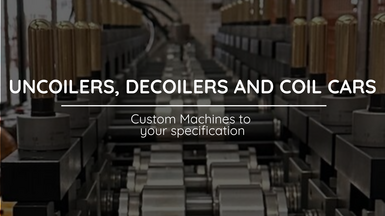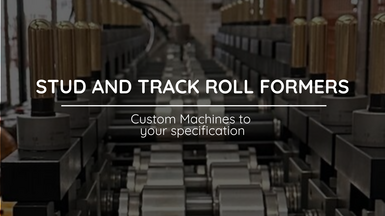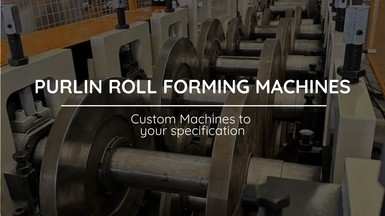
Rollformer
Rollformers are versatile machines used in various industries, including construction, automotive, aerospace, and manufacturing.
Posted on Wednesday, November 1, 2023
A rollformer, also known as a roll forming machine or a metal roll forming machine, is a piece of equipment used in the manufacturing and construction industries to shape metal sheets or strips into desired profiles or shapes. This process is known as roll forming.
Here's how a rollformer typically works:
- Material Feed: A coil or sheet of metal (often steel or aluminum) is fed into the rollformer.
- Roll Forming Stations: The rollformer consists of a series of rollers or rolls, each of which gradually bends the metal into the desired shape as it passes through. These rolls are designed in sets to match the desired profile or cross-section of the final product.
- Progressive Bending: As the metal passes through each roll station, it undergoes incremental bending and shaping. Each set of rolls is responsible for a specific part of the final shape, and the metal is gradually formed as it moves through these stations.
- Cut-off or Shearing: After passing through all the roll stations, the continuous profiled metal is typically cut to the desired length by a cutting or shearing mechanism.
- Collection and Stacking: The finished, cut pieces are then collected and stacked for further processing or transport.
Rollformers are versatile machines used in various industries, including construction, automotive, aerospace, and manufacturing. They are capable of producing a wide range of products, such as roofing panels, steel studs, door frames, automotive parts, and more. The specific design and setup of a rollformer depend on the intended product and its required profile or shape.
The advantages of roll forming include high production speed, consistency in profile accuracy, and the ability to produce long lengths of metal products. It is an efficient method for mass-producing components with complex cross-sections.
What profiles can a rollformer make
Rollformers are versatile machines capable of producing a wide variety of profiles or shapes from metal sheets or strips. The specific profiles that a rollformer can create depend on the design and configuration of the machine's roller tooling. Here are some common types of profiles that rollformers can produce:
- C-Channels: Rollformers are often used to create C-channel profiles, which are widely used in construction for framing and structural applications.
- Z-Channels: Similar to C-channels, Z-channels have a distinctive Z-shaped cross-section. They are used in various applications, including as supports for metal roofing and cladding.
- U-Channels: U-channels have a U-shaped cross-section and find use in applications such as edging, framing, and support.
- Hat Sections: Hat sections have a cross-sectional shape that resembles the brim of a hat. They are often used in the construction of steel frames and beams.
- Angle Profiles: Rollformers can create angle profiles with equal or unequal legs, which are commonly used in construction and manufacturing for corner reinforcement and framing.
- Decking Profiles: Rollformers are used to create profiles for metal decking used in composite floor systems in construction.
- Roofing and Siding Panels: Rollformers are frequently employed to produce roofing and siding panels with various profiles, including corrugated, ribbed, and standing seam designs.
- Tubing and Pipe Profiles: Some rollformers can be configured to produce metal tubing and pipe profiles, which are used in various industries for structural and fluid transport purposes.
- Trim Profiles: Rollformers can create various trim profiles used in construction and architectural applications, including drip edges, fascia, and soffit profiles.
- Automotive Profiles: Rollformers are used in the automotive industry to produce components like door frames, window channels, and bumper reinforcements.
- Shelving and Racking Profiles: Rollformers can create profiles for shelving and racking systems used in warehouses and storage facilities.
- Electrical Enclosure Profiles: These profiles are used to create enclosures for electrical and electronic equipment.
- Conveyor Rail Profiles: Rollformers can produce conveyor rail profiles used in material handling systems.
- Solar Panel Mounting Profiles: In the renewable energy industry, rollformers are used to create profiles for mounting solar panels.
- Custom Profiles: Rollformers can be customized to create unique profiles tailored to specific applications or industries.
The flexibility and versatility of rollforming technology make it a popular choice for manufacturing a wide range of metal profiles efficiently and consistently. Manufacturers can adjust and customize the rollforming tooling to meet the specific requirements of their products.
Rollformer Prices
The price of a rollformer can vary widely depending on several factors, including the type of machine, its size, capacity, features, brand, and where it's purchased. Here are some general price ranges for different types of rollformers:
- Entry-Level or Benchtop Rollformers: These are smaller, more basic machines suitable for light-duty applications or small-scale production. They typically cost anywhere from a few thousand to several thousand dollars.
- Mid-Range Rollformers: These rollformers are more versatile and may have additional features and capabilities. Prices for mid-range machines can range from around $10,000 to $50,000 or more, depending on the specifications.
- High-End or Industrial Rollformers: These are heavy-duty machines designed for high-volume production and may have advanced automation and customization options. Prices for industrial rollformers can start at $50,000 and go up significantly, potentially reaching hundreds of thousands of dollars.
- Custom Rollformers: Rollformers designed for specific, unique profiles or applications can be more expensive due to the engineering and customization involved. The price for custom rollformers can vary widely depending on the complexity of the project.
- Used Rollformers: Used or refurbished rollformers can be an economical option. Prices for used machines will depend on their age, condition, brand, and features. They can range from a fraction of the cost of a new machine to a significant portion, depending on their condition and capabilities.
It's important to note that these price ranges are general estimates, and actual prices can vary significantly based on individual circumstances. Additionally, factors such as shipping, installation, and any necessary tooling or accessories should be considered when budgeting for a rollformer.
When purchasing a rollformer, it's advisable to:
- Determine your specific production needs, including the type of profiles you need to create, production volume, and material specifications.
- Research reputable manufacturers and suppliers to find the right machine for your requirements.
- Request quotes from multiple suppliers to compare prices and features.
- Consider the long-term costs of ownership, including maintenance, energy consumption, and potential future upgrades.
- Factor in any additional costs for training, spare parts, and ongoing support.
- Evaluate the warranty and after-sales service provided by the manufacturer or supplier.
Overall, the price of a rollformer is an important consideration, but it should be weighed against the machine's capabilities, reliability, and suitability for your specific production needs.
Roll Forming Machines LLC's New Factory
Posted on Sunday, March 23, 2025
We have relocated factories, which will be available for tours very soon.

Uncoiler, Decoiler and Coil Car Roll Forming Machine Accesories from Roll Forming Machines LLC
Posted on Sunday, November 24, 2024
Contact us today with your specifications for a custom Uncoiler, Decoiler or Coil Car at [email protected] or call us at (+1) (407) 859 1119

Stud and Track Roll Forming Machines from Roll Forming Machines LLC
Posted on Saturday, November 23, 2024
Contact us today with your specifications for a custom Stud and Track Machine at [email protected] or call us at (+1) (407) 859 1119

Cee and Zee Purlin Roll Forming Machines from Roll Forming Machines LLC
Posted on Saturday, November 23, 2024
Contact us today with your specifications for a custom Cee and Zee Purlin Machine at [email protected] or call us at (+1) (407) 859 1119